Cricket Statistics
Cricket is a game rich in statistical information. Over multiple games within a series, season, or an entire career,
each player accumulates a set of statistics that can be used to compare the performances of different players.
Statistics for different classes of matches are recorded separately, in particular a top-level player would have
statistics recorded for:
- Test matches.
- One-day internationals.
- First class matches, including Test matches.
- List-A one-day matches, including one-day internationals.
Batting Statistics
The statistics accumulated for a batsman are:
- Matches: The number of matches played.
- Innings: The number of innings batted.
- Not Outs: The number of not out innings - not including times when the player did not bat.
- Runs: The number of runs scored.
- High Score: The highest score achieved in a single innings.
- Balls: The number of balls faced. ( Extra Detail: This has only been recorded sporadically in the 1970s and consistently since the 1980s, so is not known for many older players.)
- Hundreds: The number of times the batsman scored 100 or more runs in a single innings.
- Fifties: The number of times the batsman scored 50 to 99 runs in a single innings.
There are also two calculated statistics.
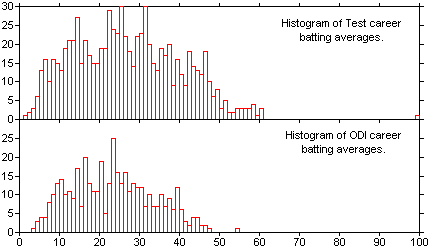 A batting average represents how many runs, on average, a batsman scores
before getting out. The higher the batting average, the better the batsman's ability to score runs without getting out.
A batting average represents how many runs, on average, a batsman scores
before getting out. The higher the batting average, the better the batsman's ability to score runs without getting out.
- Batting Average: Runs divided by (number of times out) = Runs divided by (Innings - Not Outs).
Batting averages are usually expressed to two decimal places. If a batsman has scored runs but not been dismissed, his
batting average is technically infinite, but is usually expressed simply as "no batting average". The graph shows the
distribution of career batting averages for all Test and one-day international players who have batted at least 20 innings.
Test batting averages over a career are mostly between 10 and 40. Averages are roughly considered as follows:
- Under 10: A player selected solely for bowling ability, and very poor at batting.
- 10 to 20: A player selected solely or primarily for bowling ability.
- 20 to 30: A player probably selected primarily for bowling, but also a reasonable batsman.
- 30 to 40: A player probably selected primarily for batting; a good batsman.
- 40 to 50: A very good batsman.
- Above 50: An exceptionally good batsman.
The graph shows one batsman with a Test career average of 99.94. This is Sir Donald Bradman, who played for Australia
from 1928 to 1948, and is universally recognised as the greatest cricket player in history. As you can see, nobody else
has even come remotely close to equalling his batting ability.
Battng averages in one-day internationals tend to be lower than in Test matches, because there is no time to build truly
large innings, and because the emphasis is more on scoring runs quickly than on not getting out, so batsmen more often
sacrifice their wickets in an attempt to score faster.
 A strike rate represents how many runs, on average, a batsman scores for every
100 balls he faces. The higher the batting strike rate, the better the batsman's ability to score runs quickly.
A strike rate represents how many runs, on average, a batsman scores for every
100 balls he faces. The higher the batting strike rate, the better the batsman's ability to score runs quickly.
- Strike Rate: Runs divided by Balls multiplied by 100.
Strike rates are usually expressed to two decimal places. The graph shows the distribution of career batting strike
rates for Test and one-day international players who have batted at least 20 innings. Note that the number
of balls faced is only available for Test players beginning from the 1970s and consistently from the mid 80s, thus
restricting the sample size below that available for Test batting averages.
Test batting strike rates over a career are mostly between 30 and 60.
Batting strike rates in one-day internationals are significantly higher than in Test matches, because of the emphasis on scoring
runs quickly, within the allotted number of overs.
For further analysis of batting statistics, see Statistical Analysis of Cricket.
Bowling Statistics
The statistics accumulated for a bowler are:
- Overs: The number of overs bowled. ( Extra Detail: Note this must be combined with
information on the number of balls per over in use at the time, to arrive at the total number of balls bowled. For
statistical calculations it is actually more practical to count accumulated balls bowled.)
- Maidens: The number of maiden overs bowled.
- Runs: The number of runs conceded.
- Wickets: The number of wickets taken.
- Best Bowling in an Innings: The best bowling figures achieved in a single innings.
- Five Wicket in an Innings: The number of times the bowler took five or more wickets in a single innings.
- Ten Wickets in a Match: The number of times the bowler took ten or more wickets in a match.
There are also three calculated statistics.
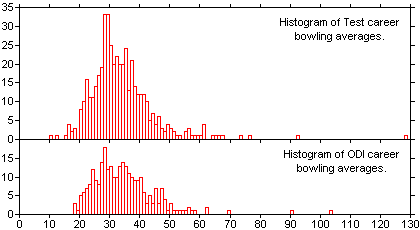 A bowling average represents how many runs, on average, a bowler concedes
per wicket he takes. The lower the bowling average, the better the bowler's ability to take wickets without conceding
many runs.
A bowling average represents how many runs, on average, a bowler concedes
per wicket he takes. The lower the bowling average, the better the bowler's ability to take wickets without conceding
many runs.
- Bowling Average: Runs divided by Wickets.
Bowling averages are usually expressed to two decimal places. The graph shows the distribution of career bowling averages
for all Test players and one-day international players who have bowled at least 1000 balls.
Test bowling averages over a career are mostly between 20 and 50. Averages are roughly considered as follows:
- Under 20: An exceptionally good bowler.
- 20 to 25: A very good bowler.
- 25 to 30: A good bowler.
- 30 to 35: A reasonable bowler, possibly selected more for batting ability.
- 35 to 40: A player probably selected primarily for batting, but who also bowls sometimes.
- Above 40: Almost certainly a player selected for batting ability, who bowls only occasionaly.
Bowling averages in one-day internationals follow roughly the same distribution. Although batsmen score faster, they tend
to get out faster too, as the following two statstics show.
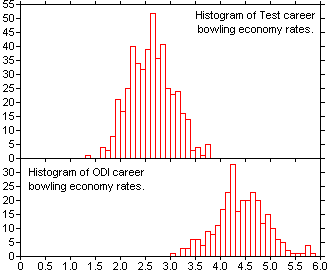 An economy rate represents how many runs, on average, a bowler concedes
per (6-ball) over he bowls. The lower the bowling economy rate, the better the bowler's ability to bowl without
conceding many runs.
An economy rate represents how many runs, on average, a bowler concedes
per (6-ball) over he bowls. The lower the bowling economy rate, the better the bowler's ability to bowl without
conceding many runs.
- Economy Rate: Runs divided by Balls multiplied by 6.
Economy Rates are usually expressed to two decimal places. The graph shows the distribution of career bowling economy rates
for all Test and one-day international players who have bowled at least 1000 balls.
Test bowling economy rates over a career are mostly between 2.0 and 3.5 runs per over.
Bowling economy rates in one-day internationals are significantly higher than in Test matches, because of the emphasis on scoring
runs quickly, within the allotted number of overs.
Strike Rate
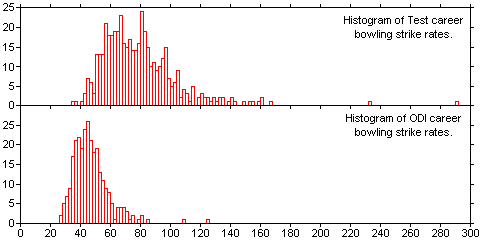 A bowling strike rate represents how many balls, on average, a bowler bowls
for each wicket he takes. The lower the bowling strike rate, the better the bowler's ability to take wickets.
A bowling strike rate represents how many balls, on average, a bowler bowls
for each wicket he takes. The lower the bowling strike rate, the better the bowler's ability to take wickets.
- Strike Rate: Balls divided by Wickets.
Strike Rates are usually expressed to two decimal places. The graph shows the distribution of career bowling strike rates
for all Test and one-day international players who have bowled at least 1000 balls.
Test bowling strike rates over a career are mostly between one wicket every 60 to 100 balls.
The long tail of players with higher strike rates are mostly batsmen who bowl occasionally.
Bowling strike rates in one-day internationals tend to be lower than in Test matches, because the batsmen are not as
protective of their wickets, since they are trying to score runs faster.
Fielding Statistics
|
In baseball, errors made by a fielder are officially assigned by the scorer and counted as a statistic.
In cricket, fielding errors are not recorded and do not form a statistic of interest. (The captain,
bowler, and fans will be unimpressed, though.)
|
The statistics accumulated for a fielder, including a wicket-keeper are:
- Catches: The number of catches taken to dismiss batsman.
- Stumpings: The number of successful stumpings achieved as a wicket-keeper.
Fielders responsible for run outs have historically not been recorded, although there is a trend now to indicate
the fielder who threw the ball to the wicket and/or the fielder who gathered the ball at the wicket and hit the stumps
with it in the scorecard, in parentheses after the "run out" notation. This is not recorded as part of a fielders
statistics though.
Other Statistics
Partnerships
A partnership is when a specific pair of batsmen bat together, from the time the
previous wicket fell until one of the batsmen gets out or the innings is declared closed before the next wicket falls.
The number of runs scored by the side during a partnership - the runs scored by both batsmen plus any extras scored in
that time - is recorded as a statistic. The number can be worked out from the
fall of wicket record in a scorecard.
Partnerships are named as follows:
- First wicket partnership: from the beginning of an innings until the first wicket falls.
- Second wicket partnership: from when the first wicket falls until the second wicket falls.
- Third wicket partnership: from when the second wicket falls until the third wicket falls.
- etc...
- Tenth wicket partnership: from when the ninth wicket falls until the tenth wicket falls.
Extra Detail:
Partnerships are defined by the falls of wickets, not by the batsmen. If a batsman retires hurt,
three different batsmen will contribute to the one partnership.
Graphical Statistics
Some statistics vary in two dimensions - either spatially or a value changing over time - and these are most easily
presented as graphics.
Batting Shot Placement (Wagon Wheel)
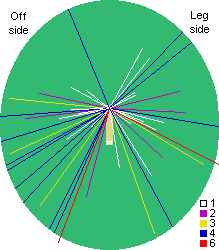 A wagon wheel is a graphic representing the top view of a cricket field,
with lines drawn from the striker's wicket into the field to indicate the path of balls hit by a batsman. Often the
lines are colour-coded to indicate the number of runs scored from each hit. Usually the lines are drawn from only one
wicket, showing the directions relative to the striker's wicket, regardless of which physical end of the pitch was
actually the striker's end at any time.
A wagon wheel is a graphic representing the top view of a cricket field,
with lines drawn from the striker's wicket into the field to indicate the path of balls hit by a batsman. Often the
lines are colour-coded to indicate the number of runs scored from each hit. Usually the lines are drawn from only one
wicket, showing the directions relative to the striker's wicket, regardless of which physical end of the pitch was
actually the striker's end at any time.
A wagon wheel shows clearly whether a batsman has scored runs more easily on the off or leg sides, and behind, square,
or forward of the wicket. This can show the strengths and weaknesses of a particular batsman - a batsman who mostly
scores square on the off side has a good cut shot, while one who scores predominantly on the leg side might be a good
puller of the ball. A side can use wagon wheels of opponents to formulate field settings and bowling lines to attack
particular batsmen more effectively.
Runs Per Over (Manhattan)
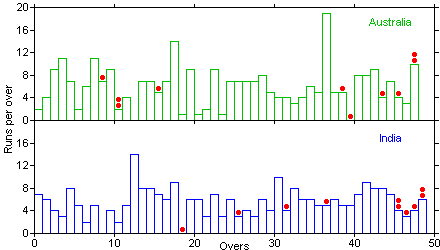 A manhattan is a bar graph showing the number of runs scored in each over of
an innings. Wickets are also generally shown, plotted as obvious dots on top of the bar in the over in which they occur.
This gives an indication of the consistency of scoring throughout the innings, showing any periods of good scoring or
particularly slow scoring, and how they relate to the falls of wicket.
A manhattan is a bar graph showing the number of runs scored in each over of
an innings. Wickets are also generally shown, plotted as obvious dots on top of the bar in the over in which they occur.
This gives an indication of the consistency of scoring throughout the innings, showing any periods of good scoring or
particularly slow scoring, and how they relate to the falls of wicket.
Manhattans are mostly used during one-day matches - where scoring rate is more important than in a two-innings match -
to give the audience an idea of scoring rates.
Run Rate Per Over (Worm)
 A worm is a line graph showing the run rate plotted
against the number of overs bowled in an innings. Wickets are also generally shown, plotted as obvious dots on the line
in the over in which they occur. This gives an indication of the average scoring progress throughout the innings and
can dramatically show any significant increases or decreases in the scoring rate.
A worm is a line graph showing the run rate plotted
against the number of overs bowled in an innings. Wickets are also generally shown, plotted as obvious dots on the line
in the over in which they occur. This gives an indication of the average scoring progress throughout the innings and
can dramatically show any significant increases or decreases in the scoring rate.
Like manhattans, worms are mostly used during one-day matches. During the second innings of a one-day match, the worm of
the side batting second is usually overlaid on the worm of the first side, giving a good idea of the comparative
run rates throughout the match, and a good indication of which side is currently in a stronger position to win.
Cumulative Runs Per Over
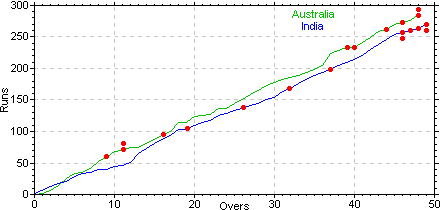 A cumulative runs per over graph (sometimes also called a worm) is a line graph showing
the cumulative run total for a side plotted against the number of overs bowled in an innings. Wickets are also generally
shown, plotted as obvious dots on the line in the over in which they occur. This gives an indication of the cumulative
scoring progress throughout the innings and better highlights any periods of slow scoring compared to a worm.
(Mathematicians will note this type of graph is essentially the integral of a manhattan.)
A cumulative runs per over graph (sometimes also called a worm) is a line graph showing
the cumulative run total for a side plotted against the number of overs bowled in an innings. Wickets are also generally
shown, plotted as obvious dots on the line in the over in which they occur. This gives an indication of the cumulative
scoring progress throughout the innings and better highlights any periods of slow scoring compared to a worm.
(Mathematicians will note this type of graph is essentially the integral of a manhattan.)
Like manhattans and worms, these graphs are mostly used during one-day matches. During the second innings of a one-day match,
the graph of the side batting second is usually overlaid on the graph of the first side, giving a good idea of the
comparative run totals throughout the match, and a good indication of which side is currently in a stronger position to win.
Records
Cricket is a game replete with records. Typical records of interest include (some may be out of date):
- Test Matches
- Team Records
- Highest innings total. 952/6 declared, Sri Lanka (v India), Colombo, 1997.
- Highest match total. 1121/19, England (v West Indies), Kingston, 1929/30.
- Batting Records
- Highest innings. 380, Matthew Hayden, Australia (v Zimbabwe), Perth, 2003/04.
- Most career aggregate runs. 11174, Allan Border, Australia, 1978/79-1993/94.
- Best career batting average. 99.94, Donald Bradman, Australia, 1928/29-1948.
- Most career centuries. 34, Sunil Gavaskar, India, 1970/71-1986/87.
- Bowling Records
- Best bowling in an innings. 10-53, Jim Laker, England (v Australia), Manchester, 1956.
- Best bowling in a match. 19-90, Jim Laker, England (v Australia), Manchester, 1956.
- Most career aggregate wickets. 519, Courtney Walsh, West Indies, 1984/85-2000/01.
- Best career bowling average. 10.75, George Lohmann, England, 1886-1896.
- Most career 5-wickets-in-an-innings: 39, Muttiah Muralitharan, Sri Lanka, 1992/93-.
- Most career 10-wickets-in-a-match: 12, Muttiah Muralitharan, Sri Lanka, 1992/93-.
- Partnership Records
- Highest 1st wicket partnership. 413, Pankaj Roy and Vinoo Mankad, India (v New Zealand), Chennai, 1955/56.
- Highest 2nd wicket partnership. 576, Roshan Mahanama and Sanath Jayasuriya, Sri Lanka (v India), Colombo, 1997.
- Highest 3rd wicket partnership. 467, Andrew Jones and Martin Crowe, New Zealand (v Sri Lanka), Wellington, 1990/91.
- Highest 4th wicket partnership. 411, Michael Cowdrey and Peter May, England (v West Indies), Birmingham, 1957.
- Highest 5th wicket partnership. 405, Donald Bradman and Sid Barnes, Australia (v England), Sydney, 1946/47.
- Highest 6th wicket partnership. 346, Jack Fingleton and Donald Bradman, Australia (v England), Melbourne, 1936/37.
- Highest 7th wicket partnership. 347, Clairmonte Depeiaza and Denis Atkinson, West Indies (v Australia), Bridgetown, 1954/55.
- Highest 8th wicket partnership. 313, Saqlain Mushtaq and Wasim Akram, Pakistan (v Zimbabwe), Sheikhupura, 1996/97.
- Highest 9th wicket partnership. 195, Pat Symcox and Mark Boucher, South Africa (v Pakistan), Johannesburg, 1997/98.
- Highest 10th wicket partnership. 151, Brian Hastings and Richard Collinge, New Zealand (v Pakistan), Auckland, 1972/73.
- Fielding Records
- Most wicket-keeping dismissals. 395 (366 catches, 29 stumpings), Ian Healy, Australia, 1988/89-1999/00.
- Most catches by non-wicket-keeper. 181, Mark Waugh, Australia, 1990/91-2002/03.
- One-Day Internationals
- Team Records
- Highest innings total. 398/5, Sri Lanka (v Kenya), Kandy, 1995/96.
- Batting Records
- Highest innings. 194, Saeed Anwar, Pakistan (v India), Chennai, 1996/97.
- Most career aggregate runs. 12878, Sachin Tendulkar, India, 1989/90-.
- Best career batting average. 54.80, Michael Bevan, Australia, 1993/94-.
- Best career batting strike rate. 104.96, Andre Adams, New Zealand, 2000/01-.
- Most career centuries. 36, Sachin Tendulkar, India, 1989/90-.
- Bowling Records
- Best bowling in an innings. 8-19, Chaminda Vaas, Sri Lanka (v Zimbabwe), Colombo, 2001/02.
- Most career aggregate wickets. 502, Wasim Akram, Pakistan, 1984/85-2002/03.
- Best career bowling average. 18.84, Joel Garner, West Indies, 1976/77-1986/87.
- Best career economy rate. 3.09, Joel Garner, West Indies, 1976/77-1986/87.
- Partnership Records
- Highest 1st wicket partnership. 258, Sourav Ganguly and Sachin Tendulkar, India (v Kenya), Paarl, 2001/02.
- Highest 2nd wicket partnership. 331, Rahul Dravid and Sachin Tendulkar, India (v New Zealand), Hyderabad, 1999/00.
- Highest 3rd wicket partnership. 275*, Mohammad Azharuddin and Ajay Jadeja, India (v Zimbabwe), Cuttack, 1997/98.
- Highest 4th wicket partnership. 232, Darryl Cullinan and Jonty Rhodes, South Africa (v Pakistan), Nairobi, 1996/97.
- Highest 5th wicket partnership. 223, Ajay Jadeja and Mohammad Azharuddin, India (v Sri Lanka), Colombo, 1997.
- Highest 6th wicket partnership. 161, Maurice Odumbe and Alpesh Vadher, Kenya (v Sri Lanka), Southampton, 1999.
- Highest 7th wicket partnership. 130, Heath Streak and Andy Flower, Zimbabwe (v England), Harare, 2001/02.
- Highest 8th wicket partnership. 126*, Kapil Dev and Syed Kirmani, India (v Zimbabwe), Tunbridge Wells, 1983.
- Highest 9th wicket partnership. 106*, Viv Richards and Michael Holding, West Indies (v England), Manchester, 1984.
- Highest 10th wicket partnership. 72, Waqar Younis and Abdul Razzaq, Pakistan (v South Africa), Durban, 1997/98.
- Fielding Records
- Most wicket-keeping dismissals. 299 (261 catches, 38 stumpings), Adam Gilchrist, Australia, 1996/97-.
- Most catches by non-wicket-keeper. 156, Mohammad Azharuddin, India, 1984/85-1999/00.
There are many other records of somewhat lesser interest, including "negative" records such as lowest innings totals.
In addition, all of these sort of records are also noted for specific match circumstances, such as:
- Matches played at a specific ground. (e.g. The highest 4th innings total at the Sydney Cricket Ground.)
- Matches played in a specific country. (e.g. The highest 2nd wicket partnership in England.)
- Records for a specific side playing against a specific opponent. (e.g. The highest innings total for New Zealand against India.)
- Matches played between specific sides. (e.g. The highest 5th wicket partnership in a match between South Africa and West Indies.)
- Records for a specific side playing in a specific country. (e.g. The lowest innings total for Sri Lanka playing in Sri Lanka.)
- Records for a specific side against all opponents. (e.g. The highest first innings lead by Zimbabwe against any opponent.)
- Individual records at a specific ground. (e.g. A player's highest score at Sabina Park, Kingston.)
- Individual records in a specific country. (e.g. A player's best bowling figures in Pakistan.)
- Individual records against a specific opponent. (e.g. A player's number of catches taken against Bangladesh.)
- Individual records in a series. (e.g. A player's aggregate number of runs in a Test series.)
- Individual records in a calendar year. (e.g. A player's aggregate number of wickets in a year.)
A much more comprehensive list of records is available at CricInfo.
Home | DM's Explanation of Cricket
Last updated: Saturday, 17 February, 2007; 15:18:10 PST.
Copyright © 1990-2025, David Morgan-Mar. dmm@dangermouse.net
Hosted by: DreamHost
 A batting average represents how many runs, on average, a batsman scores
before getting out. The higher the batting average, the better the batsman's ability to score runs without getting out.
A batting average represents how many runs, on average, a batsman scores
before getting out. The higher the batting average, the better the batsman's ability to score runs without getting out.
 A strike rate represents how many runs, on average, a batsman scores for every
100 balls he faces. The higher the batting strike rate, the better the batsman's ability to score runs quickly.
A strike rate represents how many runs, on average, a batsman scores for every
100 balls he faces. The higher the batting strike rate, the better the batsman's ability to score runs quickly.
 A bowling average represents how many runs, on average, a bowler concedes
per wicket he takes. The lower the bowling average, the better the bowler's ability to take wickets without conceding
many runs.
A bowling average represents how many runs, on average, a bowler concedes
per wicket he takes. The lower the bowling average, the better the bowler's ability to take wickets without conceding
many runs.
 An economy rate represents how many runs, on average, a bowler concedes
per (6-ball) over he bowls. The lower the bowling economy rate, the better the bowler's ability to bowl without
conceding many runs.
An economy rate represents how many runs, on average, a bowler concedes
per (6-ball) over he bowls. The lower the bowling economy rate, the better the bowler's ability to bowl without
conceding many runs.
 A bowling strike rate represents how many balls, on average, a bowler bowls
for each wicket he takes. The lower the bowling strike rate, the better the bowler's ability to take wickets.
A bowling strike rate represents how many balls, on average, a bowler bowls
for each wicket he takes. The lower the bowling strike rate, the better the bowler's ability to take wickets.
 A wagon wheel is a graphic representing the top view of a cricket field,
with lines drawn from the striker's wicket into the field to indicate the path of balls hit by a batsman. Often the
lines are colour-coded to indicate the number of runs scored from each hit. Usually the lines are drawn from only one
wicket, showing the directions relative to the striker's wicket, regardless of which physical end of the pitch was
actually the striker's end at any time.
A wagon wheel is a graphic representing the top view of a cricket field,
with lines drawn from the striker's wicket into the field to indicate the path of balls hit by a batsman. Often the
lines are colour-coded to indicate the number of runs scored from each hit. Usually the lines are drawn from only one
wicket, showing the directions relative to the striker's wicket, regardless of which physical end of the pitch was
actually the striker's end at any time.
 A manhattan is a bar graph showing the number of runs scored in each over of
an innings. Wickets are also generally shown, plotted as obvious dots on top of the bar in the over in which they occur.
This gives an indication of the consistency of scoring throughout the innings, showing any periods of good scoring or
particularly slow scoring, and how they relate to the falls of wicket.
A manhattan is a bar graph showing the number of runs scored in each over of
an innings. Wickets are also generally shown, plotted as obvious dots on top of the bar in the over in which they occur.
This gives an indication of the consistency of scoring throughout the innings, showing any periods of good scoring or
particularly slow scoring, and how they relate to the falls of wicket.
 A worm is a line graph showing the run rate plotted
against the number of overs bowled in an innings. Wickets are also generally shown, plotted as obvious dots on the line
in the over in which they occur. This gives an indication of the average scoring progress throughout the innings and
can dramatically show any significant increases or decreases in the scoring rate.
A worm is a line graph showing the run rate plotted
against the number of overs bowled in an innings. Wickets are also generally shown, plotted as obvious dots on the line
in the over in which they occur. This gives an indication of the average scoring progress throughout the innings and
can dramatically show any significant increases or decreases in the scoring rate.
 A cumulative runs per over graph (sometimes also called a worm) is a line graph showing
the cumulative run total for a side plotted against the number of overs bowled in an innings. Wickets are also generally
shown, plotted as obvious dots on the line in the over in which they occur. This gives an indication of the cumulative
scoring progress throughout the innings and better highlights any periods of slow scoring compared to a worm.
(Mathematicians will note this type of graph is essentially the integral of a manhattan.)
A cumulative runs per over graph (sometimes also called a worm) is a line graph showing
the cumulative run total for a side plotted against the number of overs bowled in an innings. Wickets are also generally
shown, plotted as obvious dots on the line in the over in which they occur. This gives an indication of the cumulative
scoring progress throughout the innings and better highlights any periods of slow scoring compared to a worm.
(Mathematicians will note this type of graph is essentially the integral of a manhattan.)